
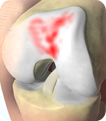
Osteoarthritis (OA) is one of the most common forms of arthritis. It is a chronic condition in which the material that cushions the joints, called cartilage, breaks down. This causes the bones to rub against each other, causing stiffness, pain and loss of joint movement. The cause is not fully understood. Symptoms Osteoarthritis symptoms usually develop gradually. At first, there may be soreness or stiffness that seems more like a nuisance than a medical concern. Common symptoms include: Sore or stiff joints – particularly the hips, knees, and lower back – after inactivity or overuse. Stiffness after resting that goes away after movement. Pain that is worse after activity or toward the end of the day. Osteoarthritis, or OA, may also affect the neck, small finger joints, the base of the thumb, ankle, and big toe. The pain may be moderate and come and go, without affecting the ability to perform daily tasks. Some people’s OA will never progress past this early stage. Others will have their OA get worse. The pain and stiffness of more severe osteoarthritis may make it difficult to walk, climb stairs, sleep, or perform other daily tasks. Diagnosis If you have symptoms of osteoarthritis, the doctor will ask questions about your medical history and perform a physical exam and, possibly, take X-rays to confirm the diagnosis. Treatment There is no cure for osteoarthritis, but there are medications to help relieve pain, when needed. The doctor may recommend physical therapy (PT) or occupational therapy (OT) to help improve strength and function. When pain is severe and frequent or mobility and daily activities become difficult, surgery may be considered. Self-care Staying physically active and maintaining a healthy weight are the keys to living well with osteoarthritis. Too little movement can lead to stiffness and weak joints. Losing one pound can take four pounds of pressure off your knee joints. Overall fitness improves health in many ways. Strong muscles protect joints. An OA management plan also involves eating a nutritious diet, managing stress and depression, and getting a good balance of rest and activity each day. What to Do If you think you might have osteoarthritis – Find out when to see a doctor.
read more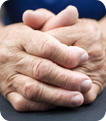
Rheumatoid arthritis (RA) is an autoimmune disease in which your body’s immune system – which protects your health by attacking foreign substances like bacteria and viruses – mistakenly attacks your joints. The abnormal immune response causes inflammation that can damage joints and organs, such as the heart. Early diagnosis and prompt treatment is the key to preventing joint destruction and organ damage. Symptoms The severity of the disease can vary from person to person. Symptoms can change from day to day. Sudden increases in symptoms and illness are called flares. A flare can last for days or months. Key rheumatoid arthritis symptoms are pain, fatigue and warm, swollen, reddish joints. Long periods of joint stiffness in the morning are common. Inflammation in the small joints of the wrist and hand is typical. If a joint on one side of the body is affected, the same one on the other side is usually affected, too. Treatment There is no cure for RA, but there are a number of medications available to help ease symptoms, reduce inflammation, and slow the progression of the disease. No one drug works for everyone but many people find treatments that are very effective. The goal of treatment is remission, a state when inflammation is gone or is very low. A doctor, likely a rheumatologist – a specialty doctor who treats people with arthritis – should monitor your levels of disease activity, or inflammation, on a regular basis through exams and blood tests that reveal how well treatment is working. The doctor may add or change your medications or adjust the dosage after a few months, if the disease is still active. Self-care Self-management is an important part of rheumatoid arthritis care. Staying physically active is the key to keeping joints flexible. Too little movement can lead to joint stiffness. Strong muscles protect joints. Overall fitness improves health in many ways. Managing your weight, eating a nutritious diet and getting a good balance of rest and activity each day are important, too.
read more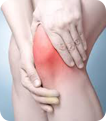
Traumatic arthritis occurs following an injury, excessive movement or physical trauma such as a penetrating wound. Sports injuries are a common cause of traumatic arthritis. This results in symptoms which are similar to those caused by most other forms of arthritis. They include pain, inflammation and a build up of fluid around the joint. This arthritis occurs if there is damage to the ‘articular cartilage’from an accident or injury which causes pain and swelling around the joint and restricts normal mobility. Treatment for this includes anti-inflammatory drugs, low impact exercise and lifestyle changes, e.g. losing weight if necessary. Surgery is an option in severe cases. Traumatic arthritis is discussed as follows: How does traumatic arthritis occur? Causes of traumatic arthritis Symptoms of traumatic arthritis Diagnosis of traumatic arthritis Tests for traumatic arthritis Treatment for traumatic arthritis Managing traumatic arthritis How does traumatic arthritis occur? This occurs following damage to the articular cartilage within a joint, e.g. knee joint which often results in osteoarthritis. To further understand this here is a quick overview of the articular cartilage. Articular cartilage This is the smooth white tissue made from collagen (protein) which is found at the end of the bones – at the point where they connect to each other as a joint. This cartilage is strong and durable and enables these bones to move in conjunction with each. For example articular cartilage in the knee allows the knee to perform a wide range of movements. Articular cartilage is described as ‘extravascular’: this means that it is located outside of the body’s vascular system (system of veins and arteries). Blood and other nutrients do not flow through it but are found outside of this tissue. This is the reason why if this cartilage becomes damaged it then takes a long time to heal. This cartilage can be bruised, ripped or even torn away from the surface of the bone. If this occurs then small fragments of cartilage can float around inside the joint, causing friction and pain. This can result in extra damage to the joint. What is important for you to know is if this cartilage becomes damaged, i.e. torn then it will not grow back. Scar tissue forms over areas of damage such as tiny holes but this is no substitute for cartilage. This tissue is not as strong or long lasting and is unable to support any weight placed on the joint. Plus any damage sustained to the joint such as a sports injury changes the work that joint works. It may be pushed out of alignment which affects the way the rest of the body works. This then speeds up the rate of wear and tear on that joint. Causes of traumatic arthritis This type of arthritis has many causes which include: Sports injury Car accident Blunt force trauma (e.g. hit by an implement) Fall Injury at work Fracture Overuse All of these result in damage to the articular cartilage, resulting in pain, swelling and tenderness. The joint feels…
read more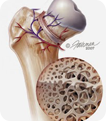
What Is Osteonecrosis? Osteonecrosis is a disease resulting from the temporary or permanent loss of blood supply to the bones. Without blood, the bone tissue dies, and ultimately the bone may collapse. If the process involves the bones near a joint, it often leads to collapse of the joint surface. Osteonecrosis is also known as avascular necrosis, aseptic necrosis, and ischemic necrosis. Although it can happen in any bone, osteonecrosis most commonly affects the ends (epiphysis) of the femur, the bone extending from the knee joint to the hip joint. Other common sites include the upper arm bone, knees, shoulders, and ankles. The disease may affect just one bone, more than one bone at the same time, or more than one bone at different times. Osteonecrosis of the jaw (ONJ) is a rare condition that has been linked to the use of biphosphonate medications. ONJ has different causes and treatments than osteonecrosis found in other parts of the skeleton. The amount of disability that results from osteonecrosis depends on what part of the bone is affected, how large an area is involved, and how effectively the bone rebuilds itself. Normally, bone continuously breaks down and rebuilds—old bone is replaced with new bone. This process, which takes place after an injury as well as during normal growth, keeps the skeleton strong and helps it to maintain a balance of minerals. In the course of osteonecrosis, however, the healing process is usually ineffective and the bone tissues break down faster than the body can repair them. If left untreated, the disease progresses, the bone collapses, and the joint surface breaks down, leading to pain and arthritis. What Causes Osteonecrosis? Osteonecrosis is caused by impaired blood supply to the bone, but it is not always clear what causes that impairment. Osteonecrosis often occurs in people with certain medical conditions or risk factors (such as high-dose corticosteroid use or excessive alcohol intake). However, it also affects people with no health problems and for no known reason. Following are some potential causes of osteonecrosis and other health conditions associated with its development. Steroid Medications Aside from injury, one of the most common causes of osteonecrosis is the use of corticosteroid medications such as prednisone. Corticosteroids are commonly used to treat inflammatory diseases such as systemic lupus erythematosus, rheumatoid arthritis, inflammatory bowel disease, severe asthma, and vasculitis. Studies suggest that long-term use of oral or intravenous corticosteroids is associated with nontraumatic osteonecrosis. Patients should discuss concerns about steroid use with their doctor. Doctors are not sure exactly why the use of corticosteroids sometimes leads to osteonecrosis. They speculate that the drugs may interfere with the body’s ability to break down fatty substances called lipids. These substances then build up in and clog the blood vessels, causing them to narrow and to reduce the amount of blood that gets to the bone. Some studies suggest that corticosteroid-related osteonecrosis is more severe and more likely to affect both hips (when occurring in the hip) than osteonecrosis resulting from…
read more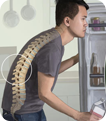
Ankylosing spondylitis (pronounced ank-kih-low-sing spon-dill-eye-tiss), or AS, is a form of arthritis that primarily affects the spine, although other joints can become involved. It causes inflammation of the spinal joints (vertebrae) that can lead to severe, chronic pain and discomfort. In the most advanced cases (but not in all cases), this inflammation can lead to new bone formation on the spine, causing the spine to fuse in a fixed, immobile position, sometimes creating a forward-stooped posture. This forward curvature of the spine is called kyphosis. AS can also cause inflammation, pain and stiffness in other areas of the body such as the shoulders, hips, ribs, heels and small joints of the hands and feet. Sometimes the eyes can become involved (known as Iritis or Uveitis), and rarely, the lungs and heart can be affected. The hallmark feature of ankylosing spondylitis is the involvement of the sacroiliac (SI) joints during the progression of the disease, which are the joints at the base of the spine, where the spine joins the pelvis. Is There a Cure? Currently, there is no known cure for AS, but there are treatments and medications available to reduce symptoms and manage the pain. Recent studies show that the new biologic medications can potentially slow or halt the disease progression in some people Causes of Ankylosing Spondylitis Although the exact cause of AS is unknown, we do know that genetics play a key role in AS. Most individuals who have AS also have a gene that produces a “genetic marker” – in this case, a protein – called HLA-B27. This marker is found in over 95% of people in the Caucasian population with AS (the association between ankylosing spondylitis and HLA-B27 varies greatly between ethnic and racial groups, see our AS Diagnosis section for more information). It is important to note, however, that you do not have to be HLA-B27 positive to have AS. Also, a majority of the people with this marker never contract ankylosing spondylitis. Scientists suspect that other genes, along with a triggering environmental factor, such as a bacterial infection, are needed to trigger AS in susceptible people. HLA-B27 probably accounts for about 40% of the overall risk, but then there are other genes working in concert with B27. There are probably five or six genes involved in susceptibility toward AS. It is thought that perhaps AS starts when the defenses of the intestines start breaking down and bacteria from the intestines pass into the bloodstream directly into the region where the sacroiliac joints are located. Who is At Risk? The risk factors that predispose a person to ankylosing spondylitis include: Testing positive for the HLA-B27 marker A family history of AS Frequent gastrointestinal infections Unlike other forms of arthritis and rheumatic diseases, general onset of AS commonly occurs in younger people, between the ages of 17-45. However, it can affect children and those who are much older. AS is more common in men, but occurs in women as well. Disease Course/Prognosis The severity of AS varies…
read more